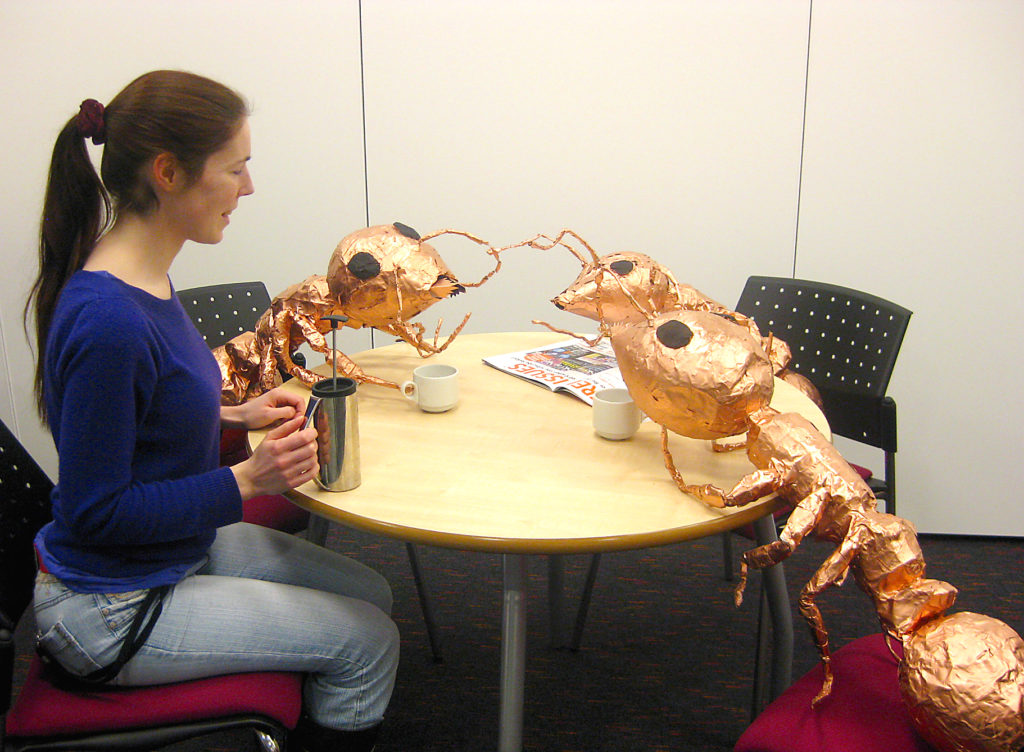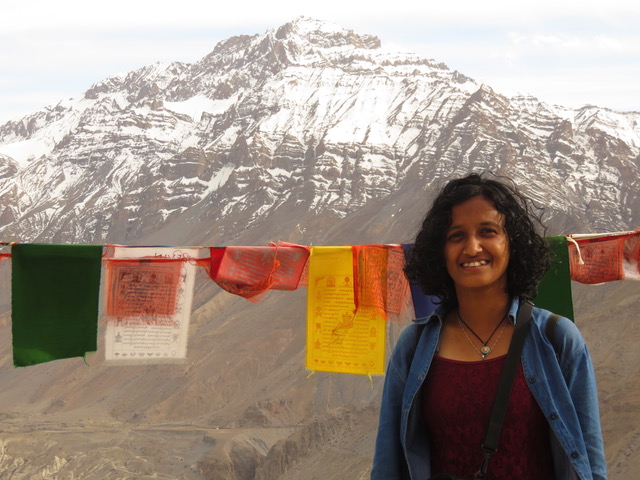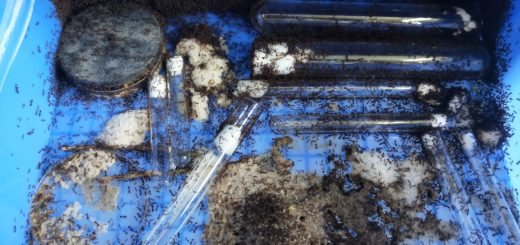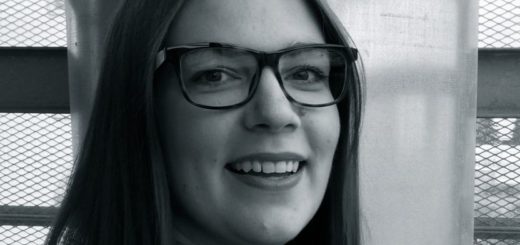Interview with Elva Robinson

Elva Robinson is a
An Interview compiled by Sheethal Vepur Ramamurthy

MNB: How did you end up studying ants?
EJHR: I have always been interested in ants. I have some early memories of being fascinated by ants in particular, but I have also been deeply interested in other aspects of the natural world my whole life. When I was an undergraduate, I was really intrigued by the evolution of cooperation, and also by the ideas of self-organisation – how individuals can know what to do and how to behave in a coordinated manner without any centralised control. That was really the hook that got me interested in researching ant behaviour.
MNB: What do you enjoy most about ant research?
EJHR: Definitely watching ants and asking questions about why they do, what they do, and how they organise themselves. How behaviour, particularly collective behaviour that we observe, can be shaped by natural selection and what are the mechanisms underlying those behaviours. I find thinking about these questions and having those questions emerge from watching ants really exciting.
MNB: What was the biggest obstacle you had to overcome in ant research?
EJHR: An ongoing problem is of course having funding, and now there are also lots of other things competing for my time, and these responsibilities make it harder to focus on my ant research.
MNB: So true. And who or what inspired you to pursue a career in myrmecology?
EJHR: I would say the ants inspired me, really. But also I was very fortunate that I grew up in a household where both my parents were very interested in the natural world, and particularly my father was an expert in natural history. So they really made it possible for me to appreciate nature and find what I was really interested in, among all the creatures out there.
MNB: Wow. And if you had not become a myrmecologist, what else would you have liked to become?
EJHR: Most of my childhood I was determined to become a palaeontologist, because I’m also very interested in fossils, and what we can learn about evolution from them.
MNB: And during your research, what was the funniest, scariest, most irritating moment, and the moment you enjoyed most?
EJHR: The most irritating or challenging field experience was working in the Northern territory of Australia. I was working with Ben Hoffmann on yellow crazy ants, which is an invasive species, but it was the native species that were the problem for us. We had possums and crows stealing our baits for the ants, and we had geckos and centipedes climbing into our arenas and eating the baits. It felt like the whole natural history of Australia was conspiring against our experiments. But we did manage to do some good work at the end, and I certainly enjoyed the experience of working in that amazing environment.
MNB: Sounds like an adventure. Slightly different topic now: Is there any particular situation in which you typically have the crucial idea for solving a difficult problem?
EJHR: Ideas usually come to me when I’m running or some other time when I’m not staring at the screen or a piece of paper. I think the human mind is amazing how it can keep on processing problems, even when you’re not actively thinking about them.
MNB: In your opinion, what are the main differences regarding research when you started as a myrmecologist compared with today?
EJHR: There have been some incredible technological advancements – even though I would say I’m still quite early in my career so perhaps things haven’t changed so much. But we can do so much more with molecular and genetic techniques, computational and analytical methods, which were not available even just 10 years ago. It makes it possible to answer questions that previously would have been impossible or just far too time consuming and expensive, which is really exciting.
MNB: You have mentioned computational and analytical methods. Can you briefly tell us how you are incorporating them in your ant research?
EJHR: I’m interested in the emergent properties of ant colonies, and individual-based models are particularly useful for studying emergent properties because we can program individual agents to behave in a certain way and observe resulting group level patterns that are similar to the properties that we see in real ant colonies. This gives us a hypothesis about how individual ants can generate that group behaviour, and then we can go back and test that hypothesis in the lab or in the field to find out whether our model is correct. One tool that I’ve been using more recently is network models, and particularly dynamic network models. The very nature of a network is that everything is inter-connected of course this is very important in an ant colony. So, I’ve been using networks to look at the structure and function of polydomous colonies, and how ants spread out between several socially connected nests and still behave cooperatively and transfer food effectively.
MNB: Really intersting. And what do you think will be hot topics in ant research in the next ten years?
EJHR: I think that the molecular techniques that are now available are enabling us to understand better what ant species we actually have, because although in much of Europe the natural history is quite well described, in most world regions, we don’t even know what ant species are present, and even within Europe we often don’t know to what extent species are present. I think these techniques are also increasing the potential for understanding ecosystems as a whole, and the roles that ants play in those environments. I think this is extra important because of anthropogenic pressure, climate and habitat change, and because ants are ecosystem engineers. I think that there are really hot topics in understanding the roles that ants and ant communities play, how those interact with other species, how resilient such communities are to change, and whether we can use ants as indicators for the effects of change.
MNB: Do you have any suggestion for myrmecology newbies?
EJHR: Spend time getting to know your species. It is really important to understand the ecological background of the species that you are working on even if you are working on it in a lab or in a test tube doing molecular work. It is really important to spend time actually getting to know the evolutionary and ecological context of that species. And enjoy it, ants are amazing!

MNB: We now switch again
EJHR: The critical period for retaining female scientists is at the postdoc stage, particularly the transition from postdoc to permanent position. So, I think we need to support and secure the future of our postdocs and particularly those who have families or non-traditional/non-simple career paths. We need to value what they contribute and the way they progress in their career. All of us can be really good allies and mentors to help people make that transition from postdoc to permanent position.
MNB: So ture. Do you or your group harbour students/postdocs with kids?
EJHR: None of my group members have children at the moment. But speaking from my own experience, being a parent can be challenging with field work and attending conferences. I’m very fortunate that I have a very supportive partner who is willing to accompany me during conferences or field work to look after the children. Increasingly, academic societies are offering child care grants and support at conferences which is fantastic. But we do need more support and flexibility particularly around field work because this can be very challenging. I’ve moved my direction of field work away from tropical invasion biology and more towards temperate forest ecology so that I don’t have to be away from my family so much. Balancing family life with research does have a big impact, but I think it can also be positive for everybody involved.
MNB: What would you do differently if you could start all over again?
EJHR: Maybe I would have invested more time earlier in my career on building connections with people in other labs and who study other systems, because now I find that all the connections I did make are hugely valuable. It’s wonderful now having a network of collaborators and colleagues who have different knowledge and expertise and I think I could have done more in the early stages of my career to make those connections. It’s definitely something I would encourage researchers who are still at an early stage in their career to value. Because sometimes it can feel like it is not real work – building relationships and discussing science with people, versus doing science. But, actually they both are really important.
MNB: What question are you asked most often when people hear you work with ants?
EJHR: Usually people ask if I can help them get rid of ants in their house or in their garden. But I don’t answer this, instead I just tell them they are really lucky to have ants in their garden and they should watch and enjoy them.
MNB: What is the one thing you wish everyone knew about ants?
EJHR: How ecologically important and beneficial they are. Because for many people, ants are just an irritation. I try to tell people all the fantastic things ants do, such as ecosystem services that ants provide, and the important roles that they play. I wish more people understood that.
MNB: Yes, absolutely. And do you have a favorite morphological structure / myrmecological phenomenon?
EJHR: One of the things that I find fascinating about ants is polydomy – how one colony can live in lots of different nests and yet still be part of the same colony. But also how different nests can be in different local environments and even potentially play different roles within a colony and how this impacts the organization. This is an exciting area of research for me.
MNB: And do you have a favorite ant species?
EJHR: I find this question hard because I find many species fascinating. But one of my favourites is Formicoxenus nitidulus, the shining guest ant. It’s so beautiful, and also is an amazing species that has evolved to live inside the nests of Formica rufa species. It lives there a bit like a house mouse – stealing scraps of food, not harming the ants, but is also protected from them and hiding in the nest. I think it is just an amazing species and it’s very rewarding when you manage to spot it.
MNB: And if you could be an ant, what ant species would that be?
EJHR: Maybe a weaver ant. I like the idea of making my own home and they are polydomous as well. Also, they can move between nests, even across different trees, and they use their own larvae as shuttles to weave their nests.
MNB: We now again switch topic. What is the book on your bedside table?
EJHR: I’m currently reading a book called ‘Wilding’ by Isabella Tree, it’s about a big ecological restoration project in the South of England. It is really fascinating of how introducing large herbivores back to a previously arable, intensively used farm promoted incredible increases in biodiversity. It really changed the way I think about conservation.
MNB: Watching sports or doing sports?
EJHR: Doing sports.
MNB: Do you enjoy the evening or the morning?
EJHR: Evening, definitely.
MNB: Tea or coffee?
EJHR: Tea.
MNB: Habit or change, what do you prefer?
EJHR: Change.
MNB: Cooking yourself or going out having dinner?
EJHR: Cooking.
MNB: Aspirator or forceps?
EJHR: Forceps, but I’m more likely to use my fingers!
MNB: Nest densities or pitfall traps, what do you prefer?
EJHR: Nest densities.
MNB: Field work or lab?
EJHR: Field work.
MNB: Pin or ethanol?
EJHR: I try to avoid killing ants when I can. But if I have to choose one then it would be pin.
MNB: Paper printed out or reading on the laptop?
EJHR: I usually read on the laptop to try to save the environment.
MNB: Journals financed by the author (open access) or by the reader (subscription based). What do you prefer?
EJHR: I’m very strongly in favour of open access but I’m worried that putting big charges on the author may prevent the publication of projects which are not well-funded but are still valuable. So, we need to take that into consideration along with open access.
MNB: Kin selection or group selection?
EJHR: Kin selection.
MNB: Do you prefer monodomy or supercoloniality?
EJHR: I’m going to say polydomy for sure.
MNB: Do you prefer the workers or the queens in an ant colony?
EJHR: Workers.
MNB: Thank you so much for this nice interview!






Very nice interview. And…where can I get a tee-shirt like that one?
The T-shirt was from Cafe-press – I always keep my eyes open for good ones!